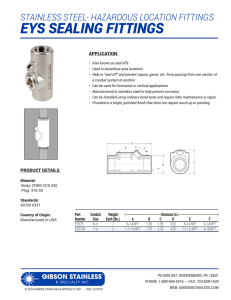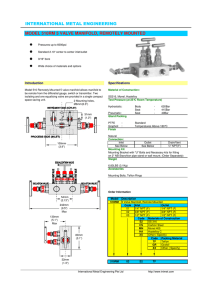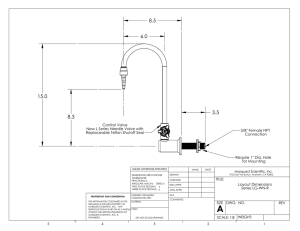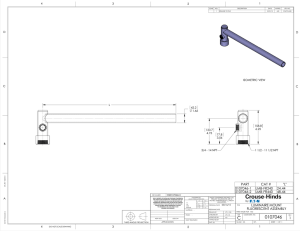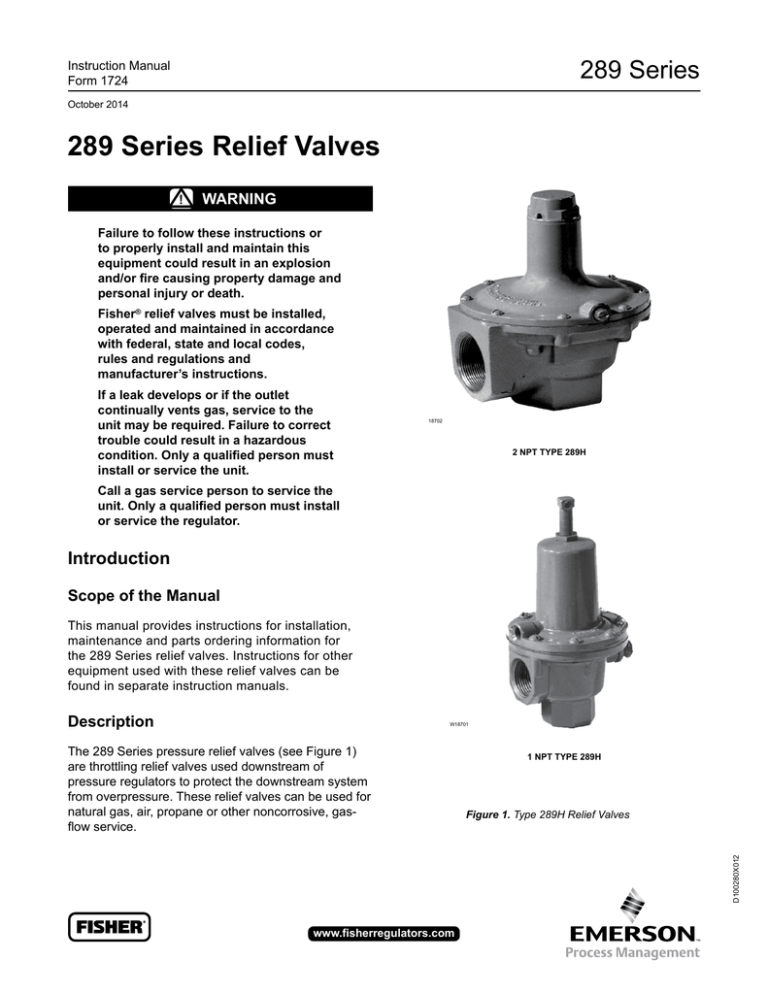
289 Series
Instruction Manual
Form 1724
October 2014
289 Series relief Valves
!
WarnIng
Failure to follow these instructions or
to properly install and maintain this
equipment could result in an explosion
and/or fire causing property damage and
personal injury or death.
Fisher® relief valves must be installed,
operated and maintained in accordance
with federal, state and local codes,
rules and regulations and
manufacturer’s instructions.
If a leak develops or if the outlet
continually vents gas, service to the
unit may be required. Failure to correct
trouble could result in a hazardous
condition. Only a qualified person must
install or service the unit.
18702
2 nPT TyPe 289H
Call a gas service person to service the
unit. Only a qualified person must install
or service the regulator.
Introduction
Scope of the Manual
This manual provides instructions for installation,
maintenance and parts ordering information for
the 289 Series relief valves. Instructions for other
equipment used with these relief valves can be
found in separate instruction manuals.
Description
W18701
1 nPT TyPe 289H
Figure 1. Type 289H Relief Valves
D100280X012
The 289 Series pressure relief valves (see Figure 1)
are throttling relief valves used downstream of
pressure regulators to protect the downstream system
from overpressure. These relief valves can be used for
natural gas, air, propane or other noncorrosive, gasflow service.
www.fisherregulators.com
289 Series
Specifications
Available Configurations
Pressure Setting Adjustment
See Table 1
Adjusting screw
Body Sizes and Inlet Connections
Pressure Registration
Type 289L: 3/4 or 1 NPT
Internal
Types 289A and 289U: 1/4 NPT
Approximate Shipping Weights
Type 289H: 1 or 2 NPT
Types 289A and 289U: 0.75 lbs / 0.3 kg
Type 289HH: 1 NPT
Maximum Allowable Relief (Inlet) Pressure
Maximum Relief Set Pressure
Type 289H:
(1)
and
See Table 1
Material Temperature Capabilities(1)
Nitrile (NBR) and Neoprene (CR):
-20 to 150°F / -29 to 66°C
Fluorocarbon (FKM)(2):
1 NPT Size: 4 lbs / 2.0 kg
2 NPT Size: 15 lbs / 7.0 kg
Type 289HH: 4 lbs / 2.0 kg
Type 289L: 15 lbs / 7.0 kg
Additional Specifications
For construction materials, see Parts List
20 to 300°F / -7 to 149°C
Available with Types 289H and 289HH only
1. The pressure/temperature limits in this Instruction Manual and any applicable standard limitation should not be exceeded.
2. Bubble-tight shutoff cannot be attained at settings below 5 psig / 0.34 bar with Fluorocarbon (FKM) O-ring seat.
Principle of Operation
Refer to Figures 2 and 4. The 289 Series Relief valves
are to be installed (between large service regulators
such as S202G or S302G Series) so the outlet is
piped downstream to relieve excess pressure to the
atmosphere. As inlet pressure increases, the spring
is compressed by the diaphragm, moving the disk
away from the seat. When the valve is opening, high
gas velocity through the orifice creates an area of
relatively low pressure near the end of the pitot tube.
This pitot tube effect forms a partial vacuum above the
diaphragm (spring case area) which helps to open the
valve further.
Installation
!
Warning
Installing a 289 Series relief valve where
its capabilities can be exceeded or where
proper operation might be impaired
may cause personal injury, property
damage or leakage due to bursting of
pressure-containing parts or explosion
2
of accumulated gas. To avoid such
conditions, install a 289 Series relief
valve where:
• Service conditions are within the
unit capabilities specified in the
Specifications section and
• The relief valve is protected from
exposure to physical damage and/or
corrosive substances.
1. When installing a 289 Series relief valve, make sure
that the installation of the system complies with
applicable local, state or federal codes or regulations.
2. Use qualified personnel when installing, operating
and maintaining a 289 Series relief valve. Before
installation, make sure there is no damage to
or foreign material in the relief valve and that all
piping is clean and unobstructed.
3. For installation of Types 289H, 289HH and 289L
relief valves, the vent in the spring case must
remain plugged or undrilled in order for the pitot
tube to function properly.
4. The 289 Series relief valves may be installed in any
orientation. However, when installing the relief valve
at an outside location, adequate protection, such as
289 Series
rain caps or elbow piping (see Figure 4), must be
attached to the outlet to keep the relief valve from
getting plugged or from collecting moisture, corrosive
chemicals or other foreign materials. If piping is to be
attached to the valve outlet, the following parts (if they
are connected to the valve outlet as shown in
Figures 6 through 10) must first be removed: the
screen (key 9), the snap ring (key 13) and the gasket
(key 15). A typical installation of a 289 Series Relief
Valve is shown in Figure 4.
!
Warning
If using a 289 Series relief valve on
hazardous or flammable gas service,
personal injury and property damage
could occur due to fire or explosion of
vented gas that may have accumulated.
To prevent such injury or damage,
provide piping or tubing to vent the gas
to a safe, well-ventilated area. Also, when
venting a hazardous gas, the piping or
tubing should be located far enough
away from any buildings or windows so
to not create a further hazard and the
vent opening should be protected against
anything that could clog it.
M1048
INlet pressure
outlet pressure
Figure 2. 2 NPT Type 289H Operational Schematic
5. Apply pipe compound to the male pipeline
threads only; do not apply pipe compound to
the internal body threads. Then install the
relief valve so that the flow through it will match
the direction arrow or marking cast on the
valve body.
When installing the molded diaphragm in the
289 Series Relief Valves, make sure the diaphragm
convolutions is installed in the down position as shown
in Figure 3.
Startup
Key numbers are shown in Figures 6 through 10.
With proper installation completed and system
equipment properly adjusted, close any vent valves
and slowly open the upstream shutoff valve while
using pressure gauges to monitor pressure.
INSTALL
DIAPHRAGM
CONVOLUTION
DOWN
Figure 3. Installation of Diaphragm
Note
To ensure proper operation of the pitot
tube, if present, the spring case (key 2)
must be tightly sealed. It is recommended
that the gasket (key 15) be replaced
whenever the closing cap (key 14) is
3
289 Series
protect vent pipe
with rain cap
289 series
relief valve
service
regulator
AJ4698-C
A2404-1
Figure 4. Typical Installation
removed. Antiseizing sealant should be
applied to the adjusting screw (key 6)
threads on valves without closing caps.
If set pressure adjustment is necessary, monitor the
inlet pressure with a gauge during the adjustment
procedure. Remove the closing cap (key 14) or loosen
the hex nut (key 11) and turn the adjusting screw (key 6)
clockwise to increase or counterclockwise to decrease
the relief pressure setting.
For 2 NPT Type 289H relief valves, when changing from
one spring range to another, it is recommended that a
new spring case be used so that the travel stop drive
screw will be positioned correctly for the corresponding
spring range. Each spring range requires that the travel
stop drive screw be positioned appropriately in the
spring case to prevent setting the relief valve pressure
too high. The location of the travel stop drive screw for
each spring and spring range is shown in Figure 5.
Shutdown
Close the upstream shutoff valve, and release all
pressure from the relief valve.
4
Maintenance
Relief valve parts are subject to normal wear and
should be inspected periodically for maintenance.
The frequency of inspection and replacement of parts
depends upon the severity of service conditions.
This section contains information for inspection
and maintenance of 289 Series relief valves.
Maintenance procedures are presented for relief valve
configurations of similar construction. Refer to the
appropriate procedure and figure for the particular
relief valve configuration when changing the control
spring to one of a different range or when inspecting,
cleaning or replacing any other relief valve parts. The
screen (key 9, Figures 6 through 9) and vent piping, if
present, should be free of foreign material that might
impair relief flow.
Note
The relief valve body (key 1, Figures 6
through 10) may remain in the pipeline
during maintenance unless replacement
of the valve body is necessary.
289 Series
Type 289H
Spring case
a
1E7020-K
A2960
Figure 5. Location of Travel Stop Drive Screw for 2 NPT Type 289H Relief Valve
Table 1. Maximum Allowable Relief (Inlet) Pressure
available
configuration
body size,
NPt
spring part
number
color
code
Type 289A
1/4
0Z056327022
1B268227022
1
spring range
(relief pressure settings)
maximum allowable relief
(INlet) pressure(1)
psig
bar
psig
bar
Silver
Silver
3 to 13
11 to 22
0.21 to 0.90
0.76 to 1.5
45
3.1
1F826927052
1D892327022
1D751527022
1D7455T0012
Pink
Red
Silver
Green
1 to 4.5
4 to 15
10 to 20
15 to 50
0.07 to 0.31
0.28 to 1.0
0.69 to 1.4
1.0 to 3.5
100
6.9
2
1B536527052
1B536627052
1B536827062
1B536927052
Dark blue
Gray
Dark green
Red Stripe
7 to 18 in. w.c.
0.5 to 2.25
1.75 to 7
4 to 10
17 to 45 mbar
0.03 to 0.16
0.12 to 0.48
0.28 to 0.69
25
1.7
Type 289HH
1
1D7455T0012
Green
45 to 75
3.1 to 5.2
100
6.9
Type 289L
3/4 or 1
13A7917X012
13A7916X012
Silver
Red Stripe
10 to 18 in. w.c.
12 to 40 in. w.c
25 to 45 mbar
30 to 99 mbar
7
0.48
Type 289U
1/4
0V060227022
0F058227022
Silver
Silver
5 to 25 in. w.c.
20 in. w.c. to 3 psig
12 to 62 mbar
50 to 207 mbar
10
0.69
Type 289H
1. This value indicates the relief pressure setting plus pressure build-up.
Table 2. Relief Set Pressure Ranges
Spring Part Number
Spring Range (Relief Pressure Setting)
Dimension A
psig
bar
In.
mm
1B536527052
7 to 18 in. w.c.
17 to 45 mbar
1B536627052
0.5 to 2.25
0.03 to 0.16
1-17/32
39
1B536827062
1.75 to 7
0.12 to 0.48
2-5/32
55
1B536927052
4 to 10
0.28 to 0.69
2-5/16
59
Drive screw not required
5
289 Series
!
Warning
Avoid personal injury or property
damage from sudden release of
pressure or explosion of accumulated
gas. Before starting disassembly:
• Isolate the relief valve from line
pressure, and
• Release trapped pressure from the
valve body and pressure line.
Type 289A
All key numbers are shown in Figure 6.
1. Loosen the hex nut (key 11), and unscrew
the adjusting screw (key 6) to relieve
spring compression.
2. Unscrew the machine screws (key 8), and remove
the spring case (key 2), the spring seat (key 4), the
spring (key 7), the diaphragm head (key 3) and the
diaphragm (key 5).
3. Inspect the diaphragm and seating surfaces for
damage or wear and replace parts as necessary.
To remove the orifice (key 10) unscrew it from
the body.
4. Reinstall the orifice, the diaphragm, the diaphragm
head, the spring and the spring seat.
5. Reattach the spring case using the machine screws.
6. If a new spring with a different range is installed,
stamp the spring case with the new spring range.
7. Adjust the spring compression according to the
procedures outlined in the Startup section.
Type 289U
All key numbers are shown in Figure 7.
1. Loosen the hex nut (key 11), and unscrew
the adjusting screw (key 6) to relieve
spring compression.
2. Unscrew the machine screws (key 8), and
remove the spring case (key 2), the spring seat
(key 4), the spring (key 7) and the diaphragm
assembly (key 5).
3. Inspect the diaphragm assembly and seating
surfaces for damage or wear and replace parts
as necessary.
4. Reinstall the diaphragm assembly, the spring and
the spring seat.
5. Reattach the spring case using the
machine screws.
6
6. If a new spring with a different range is installed,
stamp the spring case with the new spring range.
7. Adjust the spring compression according to the
procedures outlined in the Startup section.
Type 289L
All key numbers are shown in Figure 8.
1. Remove the closing cap (key 14) and the gasket
(key 15), and then unscrew the adjusting screw
(key 6) to relieve spring compression.
2. Unscrew the machine screws (key 8), and then
remove the spring case (key 2), the spring
(key 7) and the diaphragm assembly (key 5).
3. Inspect the diaphragm and seating surfaces for
damage or wear and replace parts as necessary.
To remove the orifice (key 10), unscrew it from
the body. Check the pitot tube in the diaphragm
assembly for blockage, and remove any foreign
material that might impair proper operation of the
relief valve.
4. Reinstall the orifice, the diaphragm assembly and
the spring.
5. Reattach the spring case using the
machine screws.
6. If a new spring with a different range is installed,
stamp the closing cap with the new spring range.
7. Adjust the spring compression according to the
procedures outlined in the Startup section, and
then reinstall the closing cap and gasket.
Types 289HH and 1 NPT 289H
All key numbers are shown in Figure 9.
1. Loosen the hex nut (key 11), and then
unscrew the adjusting screw (key 6) to relieve
spring compression.
2. Unscrew the machine screws (key 8), and
remove the spring case (key 2), the spring seat
(key 4) and the spring (key 7).
3. Unscrew the hex nut (key 24), and remove the
lower spring seat (key 17), the diaphragm head
(key 3) and the diaphragm (key 5).
4. Unscrew the machine screws (key 29), and then
remove the stem guide assembly (key 31) and
attached parts from the valve body (key 1).
5. Slide the spacer (key 23) and the pitot tube
(key 18) and attached parts from the valve body.
6. Remove the washer (key 27), the gasket (key 19),
the spacer, the O-rings (key 30), the O-ring holder
(key 21), the O-ring (key 20) and the O-ring washer
(key 22) from the pitot tube.
289 Series
7. Inspect the O-rings, the gaskets, the spacer, the
orifice and the seating surfaces for damage or
wear, and replace parts as necessary.
8. Inspect the O-rings, the gaskets, the spacer, the
orifice and the seating surfaces for damage or
wear, and replace parts as necessary.
8. Apply anti-seizing sealant to the adjusting screw
threads and to the end of the adjusting screw that
contacts the spring seat.
9. Apply anti-seizing sealant to the orifice threads,
and then to the adjusting screw threads.
9. Slide the O-ring washer, the O-rings (keys 30 and
20), the O-ring holder, the O-ring (key 30), the
spacer, the stem guide assembly, the gasket and
the washer (key 27) onto the pitot tube.
10. Reinstall the stem guide assembly with attached
parts into the valve body, and then attach this
assembly with the machine screws (key 29).
11. Replace the diaphragm, the diaphragm head
and the lower spring seat, and then secure these
parts with the hex nut (key 24).
12. Reinstall the spring and the spring seat, and then
attach the spring case to the valve body using
the machine screws (key 8).
13. If a new spring with a different range is installed,
stamp the spring case with the new spring range.
14. Adjust the spring compression according to the
procedures outlined in the Startup section.
2 NPT Type 289H
All key numbers are shown in Figure 10.
1. Remove the closing cap and the gasket (keys 14
and 15), and then unscrew the adjusting screw
(key 6) to relieve spring compression.
2. Unscrew the machine screw (key 8), and remove
the spring case (key 2), the washer (key 27) and
the spring (key 7).
3. Unscrew the hex nut (key 24), unscrew the lifting
stem (key 25), and then unscrew the hex nut
(key 11).
4. Remove the lower spring seat (key 17), the
diaphragm head (key 3), the diaphragm (key 5),
the lower diaphragm head (key 26) and the
gasket (key 19).
5. Unscrew the machine screws (key 29), and then
remove the stem guide assembly (key 31) and
attached parts.
6. Slide the spacer (key 23) and the pitot tube (key 18)
and attached parts out of the stem guide assembly.
7. Remove the gaskets (key 19), the spacer
(key 23), and the O-ring washer (key 22) from the
pitot tube. Then remove the O-ring washer
(key 22) and the orifice (key 10) from the valve
body (key 1).
10. Reinstall the orifice and the O-ring (key 20) into
the valve body.
11. Slide the gasket, the O-ring washer, the gasket,
the spacer, the stem guide assembly and the
gasket onto the pitot tube.
12. Reinstall the stem guide assembly with attached
parts into the valve body, and attach it with the
machine screws (key 29).
13. Replace the lower diaphragm head, the
diaphragm, the diaphragm head and the lower
spring seat; then secure these parts with the hex
nut (key 11). Screw in the lifting stem, and lock it in
place with the hex nut (key 24).
14. Reinstall the spring and the washer.
Note
For 2 NPT Type 289H relief valves,
when changing from one spring range
to another, use a new spring case to
position the travel stop drive screw
correctly for the corresponding spring
range. Each spring range requires that
the travel stop drive screw be positioned
appropriately in the spring case to
prevent setting the relief valve pressure
too high. The location of the travel stop
drive screw for each spring and spring
range is shown in Figure 5.
15. Attach the spring case to the valve body using
the machine screws (key 8).
16. If a new spring with a different range is installed,
stamp the spring case with the new spring range.
17. Adjust the spring compression according to the
procedures outlined in the Startup section. Then
install the gasket and the closing cap.
Parts Ordering
When corresponding with your local Sales Office about
this equipment, always reference the equipment serial
number stamped on the spring case (key 2) or the
closing cap (key 14). When ordering replacement parts,
specify the complete 11-character part number of each
required part as found in the following parts list.
7
289 Series
7
11
6
3
2
8
4
10A744-A
1
10
5
9
Figure 6. Type 289A Relief Valve
Parts List
Key Description Parts Kit (included are keys 5, 9, 15, 19,
20, 30 and 38). Screen is Stainless steel
and gaskets are composition and Neoprene (CR).
Type 289A (include keys 5 and 9 only)
Neoprene (CR) diaphragm Type 289L (include keys 5, 9 and 15 only)
Nitrile (NBR) diaphragm and O-rings
3/4 NPT body 1 NPT body Types 289H (1 NPT body) and 289HH
Nitrile (NBR) diaphragm and O-rings Fluorocarbon (FKM) diaphragm and O-rings Type 289H, 2 NPT body (include keys 5,
9, 15, 19, 20 and 38)
Nitrile (NBR) diaphragm and O-rings Fluorocarbon (FKM) diaphragm and O-rings Type 289U (include keys 5 and 9 only)
Nitrile (NBR) diaphragm 1 Valve Body
Type 289A, Zinc Type 289U, Zinc Types 289H (1 NPT body)
and 289HH, Aluminum Type 289H (2 NPT body), Cast iron Type 289L, Aluminum
3/4 NPT body 1 NPT body Part Number
R289AX00012
R289LX00012
R289LX00022
R289HX00012
R289HX00032
R289HX00022
R289HX00042
R289UX00012
0Y071044022
0B043844012
3U888208012
31B1992X012
3L407008012
3L406908012
Key Description 2 Spring Case/Spring Case Assembly
Type 289A, Zinc Types 289H (1 NPT body)
and 289HH, Aluminum Type 289H (2 NPT body), Zinc/steel Type 289L, Aluminum Type 289U, Zinc 3 Diaphragm Head
Type 289A, Aluminum Type 289H, Zinc-plated steel
1 NPT body 2 NPT body Type 289HH, Zinc-plated steel 4 Spring Seat
Type 289L, Zinc-plated steel
Type 289A, Brass Type 289U, Zinc-plated steel Types 289H (1 NPT body)
and 289HH, Zinc-plated steel 5* Diaphragm/Diaphragm Assembly
Type 289A, Neoprene (CR) Types 289H (1 NPT body) and 289HH
Nitrile (NBR) Fluorocarbon (FKM) Type 289H (2 NPT body)
Nitrile (NBR)
Fluorocarbon (FKM) Type 289L
Nitrile (NBR)(1), 3/4 and 1 NPT
bodies, (standard) Type 289U(2), Nitrile (NBR)
*Recommended Spare Parts
1. Assembly also includes an Aluminum pitot tube and brushing, a Zinc-plated steel spring seat and diaphragm head and a Neoprene (CR) seat pad.
2. Assembly also includes a Zinc diaphragm head.
8
Part Number
0B061644022
1P901708012
1E7020X0012
3L3338X0012
0B061644022
0T022744022
1D666428982
0W020225072
1P901425062
1L406525072
0T022614012
1B372544022
1D667125072
1A505202102
24B5622X012
1E606602342
24B6447X012
1D780002332
AL4068X0062
18A2815X012 289 Series
7
3
2
8
4
18A2816-A
1
10
5
9
Figure 7. Type 289U Relief Valve
Key Description 6 Adjusting Screw
Type 289A, Brass Types 289H (1 NPT body)
and 289HH, Zinc-plated steel Type 289H (2 NPT body), Zinc Type 289L, Delrin® Type 289U, Brass 7 Spring 8 Machine Screw, Plated steel
Type 289A (6 required) Types 289H and 289HH,
1 NPT body, (8 required) Type 289H, 2 NPT body (8 required) Type 289L (8 required) Type 289U (6 required) 9 Screen, Stainless steel
Type 289L
3/4 NPT body 1 NPT body Types 289A and 289U
Types 289H and 289HH, 1 NPT body Type 289H, 2 NPT body 10* Orifice
Type 289A, Aluminum Type 289H (2 NPT body)
Brass Stainless steel Type 289L, Aluminum Part Number
1A568414012
1D995448702
1B537944012
T1007106642
0F058114012
See Table 1
1P474328982
1A391724052
1A407824052
T13305T0012
1A899028982
1B633538392
1E564843122
0L078343062
1E564843122
11B1994X012
0T022509012
1E702613012
1E702635072
1L406409012
Key Description Part Number
11 Hex Nut
Types 289A and 289U, Brass 1A505418992
Types 289H (1 NPT body)
and 289HH, Zinc-plated steel 1D667728982
Type 289H (2 NPT body)
Zinc-plated steel 1D780124272
Zinc 1A309324122
13 Snap Ring
Type 289L, Stainless steel
3/4 NPT body 1B633638992
1 NPT body 1E564937022
Types 289H and 289HH,
1 NPT body, Carbon-plated steel 13A9938X012
Type 289H, 2 NPT body, Carbon steel 10B9241X012
14 Closing Cap
Type 289H, 2 NPT body, Zinc 1B541644012
Type 289L T1007206992
15* Gasket, Neoprene (CR)
Types 289H and 289HH, 1 NPT body13A9929X012
Type 289H, 2 NPT body1P753306992
Type 289L
1E105606992
17 Lower Spring Seat, Zinc-plated steel
Types 289H and 289HH, 1 NPT body1D666625072
Type 289H, 2 NPT body1D779925062
18 Pitot Tube
Types 289H and 289HH,
1 NPT body, Aluminum 1F826209012
Type 289H, 2 NPT body
Brass 1E701914012
Stainless steel 1E701935032
*Recommended Spare Parts
Delrin® is a mark owned by E.I. du Pont de Nemours and Co.
9
289 Series
15
14
16
2
5
17
8
10
9
1
13
BL4063-E
Figure 8. Type 289L Relief Valve
Key Description 19* Gasket, Composition
Types 289H and 289HH, 1 NPT body (1 required) Type 289H, 2 NPT body (3 required) 20* O-ring
Type 289H, 1 NPT body
Nitrile (NBR)
Fluorocarbon (FKM)
Type 289H, 2 NPT body
Nitrile (NBR) Fluorocarbon (FKM) Type 289HH
Nitrile (NBR) Fluorocarbon (FKM) 21 O-ring Holder, Aluminum
Types 289H and 289HH, 1 NPT body 22 O-ring Washer
Types 289H and 289HH,
1 NPT body, Aluminum Type 289H, 2 NPT body, Stainless steel
23 Spacer
Types 289H and 289HH,
1 NPT body, Stainless steel Type 289H, 2 NPT body
Brass Stainless steel 24 Hex Nut, Plated steel
Types 289H and 289HH, 1 NPT body Type 289H, 2 NPT body *Recommended Spare Parts
10
Part Number 1F826804022
1D779804022
1F269206992
1F2692X0012
1P336106992
1V664606382
1F269206992
1F2692X0012
1F826409012
1F826509012
1E702136072
1F826335242
1E702214172
1E702235162
1A499724122
1B228228982
Key Description 26 Lower Diaphragm Head, Zinc-plated steel
Type 289H, 2 NPT body 27 Washer, Aluminum
Types 289H and 289HH, 1 NPT body Type 289H, 2 NPT body 28 Pipe Plug, Types 289H and 289HH, Carbon steel 29 Machine Screw, Carbon-plated steel (not shown)
Types 289H and 289HH,
1 NPT body (2 required) Type 289H, 2 NPT body (4 required) 30* O-ring, Types 289H and 289HH,
1 NPT body (2 required)
Nitrile (NBR)
Fluorocarbon (FKM) 31 Stem Guide Assembly
Types 289H and 289HH, 1 NPT body
Zinc/Brass Zinc/303 Stainless steel Type 289H, 2 NPT body
Cast iron/Brass Cast iron/303 Stainless steel 32 Lifting Lever (not shown), Steel
Type 289H, 2 NPT body 34* Diaphragm Protector (not shown),
Polytetrafluoroethylene (PTFE)
Types 289A 38* Gasket, Type 289H, 2 NPT body, Neoprene (CR) Part Number
1E703125072
1F826709012
1C680511032
T13718T0012
1H526928982
1F386528992
1D687506992
1N430406382
1F8272000A2
1F8272X0012
1E7028000A2
1E7028X00A2
0R061725092
10A5116X012
11B1993X012
289 Series
6
11
4
2
17
7
8
24
16
3
5
28
27
23
19
21
20
31
1
30
22
18
AF8260-F
15
9
13
Figure 9. Types 289HH and 1 NPT 289H Relief Valves
14
2
6
7
15
L1
27
17
11
A
3
8
5
31
29
28
S
BE7030-L
19
26
23
22
L2 20
10
18
S
1
38
9
APPLY LUBRICANTS (L) / SEALANT (S) / ADHESIVE (A)(1):
L1 = Anti-seize Compound
L2 = SILICONE GREASE
S = Thread Sealant
A = ADHESIVE
1. Lubricants, sealant and adhesive must be selected such that they meet the temperature requirements.
13
Figure 10. 2 NPT Type 289H Relief Valve
11
289 Series
Industrial Regulators
Natural Gas Technologies
TESCOM
Emerson Process Management
Regulator Technologies, Inc.
Emerson Process Management
Regulator Technologies, Inc.
Emerson Process Management
Tescom Corporation
USA - Headquarters
McKinney, Texas 75070 USA
Tel: +1 800 558 5853
Outside U.S. +1 972 548 3574
USA - Headquarters
McKinney, Texas 75070 USA
Tel: +1 800 558 5853
Outside U.S. +1 972 548 3574
USA - Headquarters
Elk River, Minnesota 55330-2445, USA
Tels: +1 763 241 3238
+1 800 447 1250
Asia-Pacific
Shanghai 201206, China
Tel: +86 21 2892 9000
Asia-Pacific
Singapore 128461, Singapore
Tel: +65 6770 8337
Europe
Selmsdorf 23923, Germany
Tel: +49 38823 31 287
Europe
Bologna 40013, Italy
Tel: +39 051 419 0611
Europe
Bologna 40013, Italy
Tel: +39 051 419 0611
Chartres 28008, France
Tel: +33 2 37 33 47 00
Asia-Pacific
Shanghai 201206, China
Tel: +86 21 2892 9499
Middle East and Africa
Dubai, United Arab Emirates
Tel: +971 4811 8100
Middle East and Africa
Dubai, United Arab Emirates
Tel: +971 4811 8100
For further information visit www.emersonprocess.com/regulators
The Emerson logo is a trademark and service mark of Emerson Electric Co. All other marks are the property of their prospective owners. Fisher is a mark owned by Fisher Controls International LLC,
a business of Emerson Process Management.
The contents of this publication are presented for informational purposes only, and while every effort has been made to ensure their accuracy, they are not to be construed as warranties or
guarantees, express or implied, regarding the products or services described herein or their use or applicability. We reserve the right to modify or improve the designs or specifications of such
products at any time without notice.
Emerson Process Management Regulator Technologies, Inc. does not assume responsibility for the selection, use or maintenance of any product. Responsibility for proper selection, use and
maintenance of any Emerson Process Management Regulator Technologies, Inc. product remains solely with the purchaser.
©Emerson Process Management Regulator Technologies, Inc., 2002, 2014; All Rights Reserved


